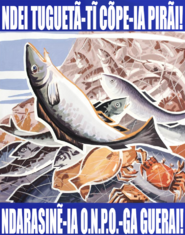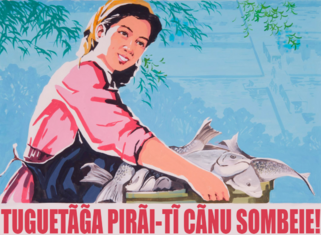Tuyan language
| Tuyan | |
|---|---|
| Tuy-Suy | |
| Tug̃uẽiñẽ | |
| Pronunciation | [tuw̃ẽɪ̯̃ˈɲẽ] |
| Native to | Hondonia |
| Region | Southern Thuadia |
| Ethnicity | Tuyan |
Native speakers | ~ (2010) |
Tuy-Suy
| |
| Dialects |
|
| Latin | |
| Official status | |
Official language in | |
Recognised minority language in |
|
| Language codes | |
| ISO 639-1 | tu |
| ISO 639-2 | tuy |
| ISO 639-3 | tuy |
Tuyan (/ˈtʰʊjən/), specifically the primary variety known as Standard Central Tuyan (Tug̃uẽiñẽ [tuw̃ẽɪˈɲẽ] "the people's language"), is a southern Thuadian language that belongs to the Tuy-Suy langauge fammily. It is one of the official languages of Hondonia (along with Rouman and Myacha), where majority of the of the population can speak it, at least half of the rural ethnic population is monolingual. It is spoken by communities in neighboring countries, including parts of Muselaria and in Merrydia where it is also an official language. It is also an official language of the Sekidean Union.
Orthodox priest Radu cel Bătrân, who in 1639 published the first written grammar of Central Tuyan in a book called Comori ale limbii tuiane (Treasure of the Tuyan Language), described it as a language "so copious and elegant that it can compete with the most famous [of languages]".
History
Political status
Iehecea
Phonology
Tuyan syllables consist of a consonant plus a vowel/diphthong or a vowel/diphthonh alone; syllables ending in a consonant or two or more consonants together do not occur. This is represented as (C)V.
Consonants
The language has 14 distinct vowels, out of which 5 have nasal equivalents:
| Labial | Alveolar | Palatal | Velar | |||||
|---|---|---|---|---|---|---|---|---|
| voiced | voiceless | voiced | voiceless | voiced | voiceless | voiced | voiceless | |
| Plosive/Affricate | ᵐb~b~m | p | ⁿd~d~n | t | t͡ɕ | k | ||
| Fricative | s | ᶮʑ~ʑ~ɲ | ɕ | ɰ~ɰ̃ ~ ɣ~ɣ̃ | x~h | |||
| Approximant | j | w~w̃ | ||||||
| Liquid | ɾ~ɺ~l | |||||||
Nasal mutation
In Tuyan the following sounds have nasal equivalents, and can mutate to ease pronounciation when in contact with a nasal vowel. Initial consonants can also be nasalized if the previous word ended in a nasal vowel. The nasal fricative and approximants are a resault of the softening of the /d͡ʑ/, /ɡ/ and /ɡʷ/ phonemes, which themselves had nasal equivalents. This mutation also helps distinguish similar words.
| Word Initial | Plain | Nasalized | |
|---|---|---|---|
| Plossive | ᵐb | b | m |
| ⁿd | d | n | |
| Fricative | ᶮʑ | ʑ | ɲ |
| ɰ~ɣ | ɰ̃~ɣ̃ | ||
| Approximant | w | w̃ | |
Vowels
Tuyan has 6 oral and 6 nasal vowels:
| Front | Central | Back | ||
|---|---|---|---|---|
| Close | oral | i ⟨i⟩ | u ⟨u⟩ | |
| nasal | ĩ ⟨ĩ⟩ | ũ ⟨ũ⟩ | ||
| Open | oral | e ⟨e⟩ | a ⟨a⟩ | o ⟨o⟩ |
| nasal | ẽ ⟨ẽ⟩ | ã ⟨ã⟩ | õ ⟨õ⟩ | |
Stress
The stress of a word usually falls on the last sylalble, unless theres a nasal syllable or syllables, in which case the stress falls on the last nasal sylalble:
- njaguá (cat), hohé (stone), guirú (money)
- guacã́ri (cougar), pirã́ (fish), cṍpe (more)
Writing system
The Tuyan script was first developed by orthodox missionaries in the colony of Noua Rumânie in the early 17th century, and therefore has a lot in common with the Rouman orthography. Tildes were added on several of the letters to express the nasal sounds, as well as the addition of ⟨gu⟩ and ⟨g̃u⟩ as seperate letters due to them being common in the language.
Besides the 36 letters, there are also 3 digraphs ⟨mb, nd, nj⟩, which exist due to the plossives being prenasalized in word initial possitions, and also the accented i ⟨í⟩ and u ⟨ú⟩, which exist to distinguish the semi-vowel from the proper vowel.
Out of the 36 letters, 9 are used only in foreign words and loans.
| А а | Ã ã | B b | C c | D d | E e | Ẽ ẽ | F f | G g |
| G̃ g̃ | Gu gu | G̃u g̃u | H h | I i | Ĩ ĩ | J j | K k | L l |
| M m | N n | Ñ ñ | O o | Õ õ | P p | Q q | R r | S s |
| Ș ș | T t | U u | Ũ ũ | V v | W w | X x | Y y | Z z |
Some letters have diferent readings depending on the vowel after them, the letter ⟨h⟩ is used to negate that:
| Group | Phoneme | Examples |
|---|---|---|
| ce, ci* | /tɕ/ | ceã (sharp), gaci (stick) |
| che, chi | /k/ | chire (to come), iche (two) |
| ge, gi | /ʑ/ | girafa (giraffe) |
| ghe, ghi | /ɣ/ | ndaghe (fast), |
| g̃e, g̃i | /ᶮʑ/ | g̃ẽ (jam) |
| g̃he, g̃hi | /ɣ̃/ | onõg̃he (rice), tanãg̃hi (boat) |
- ge/gi/g̃e/g̃i only appear in foreing loanwords.
Grammar
Nouns
Pronouns
Verbs
Sample text
"More fish for the nation!"
"Join O.N.P.O. today!"
"Let's give big fish to the people!"
Article 1 of the universal decleration of human rights:
| Common | All human beings are born free and equal in dignity and rights. They are endowed with reason and conscience and should act towards one another in a spirit of brotherhood. |
|---|---|
| Tuyan | Mbeigui tugue-ia teiõpau poi ie pete nã oibeja ie aparai. Õi-ia mẽnapau raciũnedue ie ãñajadue ie mbi ndoroga tamãnue ndaruceajarui njature ãna. |


